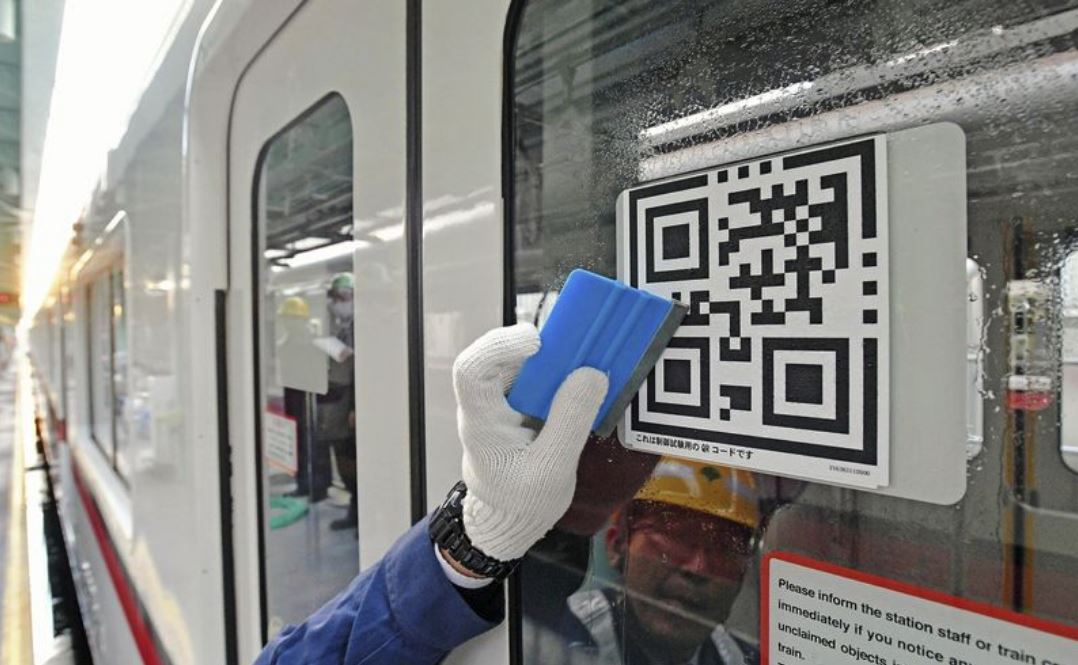QR codes to aid barrier door operation on train platforms in Japan
Sign up now: Get insights on Asia's fast-moving developments

A QR code which controls the opening and closing of doors on a platform safety barrier is seen on a subway train at a station in Ota ward, Tokyo.
PHOTO: YOMIURI SHIMBUN/ASIA NEWS NETWORK
Follow topic:
TOKYO (YOMIURI SHIMBUN/ASIA NEWS NETWORK) - In a world-first, QR codes are being used in the operation of platform safety barriers at train stations - a development aimed at accelerating the installation of barriers and slashing the hefty cost.
The new system also has the advantage of being able to handle trains with different door placements.
Safety barriers to prevent people from falling onto the tracks are being installed on station platforms ahead of the 2020 Tokyo Olympics and Paralympics. The Tokyo metropolitan government launched a practical demonstration of the new system on the municipal Toei Subway lines last month.
When a train pulls into the Toei Asakusa Line's Daimon Station in Minato Ward, doors open in a safety barrier that has been temporarily constructed on the platform. Affixed to each train door window is a QR code sticker measuring about 15cm by 15cm.
"Cameras installed on the platform read the codes, and the barrier doors located in front of the train doors open and close in unison," an official of the metropolitan government's Bureau of Transportation said proudly.
The stickers display a geometric pattern similar to the QR codes that mobile phone users read with their device's camera to connect to a dedicated website.
The metropolitan government worked with Denso Wave Inc., an Aichi Prefecture-based company that creates QR codes, to develop the world's first method for operating safety barrier doors that uses QR codes. Trials of the new system began on Nov 24.
Huge savings likely
One issue that has made installing safety barriers difficult is that trains in the Tokyo metropolitan area run through an increasing number of directly connected lines operated by different companies.
These operators run trains with differing numbers of cars and doors, so precisely opening and closing the correct safety barrier doors requires the installation of expensive communication devices in train cars.
Installation of safety barrier doors has not been completed on the Asakusa Line, which operates through services on four private railway lines operated by Keikyu Corp., Keisei Electric Railway Co., Hokuso-Railway Co. and Shibayama Railway Co.
Some trains on these lines have six cars, and others have eight. Some cars have two doors on each side, and others have three. With such a variety of train cars running on these lines, installing communication equipment needed the understanding of each rail operator - and for them to bear the financial burden.
To resolve this problem, the metropolitan government approached Denso Wave in 2015. The QR codes contain information including the number of cars in each train and the number of doors on each car.
Scanner cameras mounted on the platform ceiling read the QR codes, and this newly developed technology opens and closes the safety barrier doors located in front of the train car doors.
The cost of installing communication equipment, which according to a bureau official could amount to "tens of millions of yen for each train car formation", can now be replaced by the cost of affixing stickers on each train car.
Platform safety barriers featuring this new technology will be installed in four of the Asakusa Line's busiest stations - Shinbashi, Daimon, Mita and Sengakuji - before the 2020 Tokyo Olympics. They likely will be installed in the line's 16 other stations after the Games.
Other types being tried
The central government and railway operators aim to install platform safety barrier doors at 882 stations across Japan by fiscal 2020, when the Tokyo Olympics will be held. As of the end of March this year, they had been installed at 686 stations. However, at the 260 stations used by 100,000 or more people daily, only 84 had barriers.
Installing the barriers can often involve extending and strengthening the platforms. Rail operators are making various efforts to overcome these problems.
In 2016, East Japan Railway Co. started an experiment involving a new type of door at Machida Station on the Yokohama Line. The doors have a frame made from metal pipes that reduce the overall weight by about 30 per cent. This will reportedly eliminate the need for major strengthening work on some platforms.
Keikyu trialed a new type of platform barrier at Miurakaigan Station in Miura, Kanagawa Prefecture, until September. Trains with differing numbers of doors use this station. The new platform barrier can adjust the position of its doors so they line up with the train doors.
"The test revealed problems such as the sensor reaction speed and the length of time needed to open and close the doors," a Keikyu public relations official said. "We'll continue to consider how we can put the new system into practical use."

